Social Media Engagement with Deceptive Sites Reached Record Highs in 2020
On January 6, a mob stormed the Capitol over false claims of voter fraud. Those false claims spread widely on social media: Facebook and Twitter have been inundated with such claims since the election. The level of engagement with deceptive content on Twitter and Facebook hit record highs in 2020 and remained high in the fourth quarter of the year, as false and manipulative content about the election and the coronavirus spread widely.
In October, GMF’s Digital New Deal project launched an ongoing project that monitors engagement on social media with deceptive sites that masquerade as journalism. The Digital New Deal project partnered with NewsGuard, a nonpartisan service that rates news and information websites for their reliability, to monitor two kinds of deceptive sites:
-
Sites that NewsGuard determined repeatedly published content that is provably false (we call them “False Content Producers”).
-
Sites that NewsGuard determined failed to gather and present information responsibly without crossing its threshold of repeatedly publishing false content (we call them “Manipulators”).
We analyze data from NewsWhip, a social media intelligence firm. For Facebook, we measure interactions (likes, comments, and shares) on posts that include links to deceptive sites. For Twitter, we analyze shares (tweets and retweets) by verified accounts (that is, “blue check-marks”) of links to deceptive sites. These metrics do not always correlate with prevalence, as platforms can limit the visibility of deceptive content. However, interactions and shares are the best available metrics to analyze engagement on Facebook and Twitter, respectively.
Key Findings
On Twitter, shares by verified accounts of content from deceptive sites reached an all-time high in the fourth quarter of 2020. Such content received 47 million verified account shares, nearly one-third of the total 155 million verified account shares of links to U.S.-based sites. While verified accounts are a subset of Twitter users, they include many of the most-followed accounts that drive conversation on Twitter. Verified accounts are among the biggest vectors of disinformation on Twitter.
Verified account shares of content from False Content Producers grew faster than for Manipulators and non-deceptive media, driving much of the growth in the fourth quarter. The Gateway Pundit was particularly dominant and has seen a ninefold increase in verified account shares of its content since the first quarter of 2018. Nine of its ten most popular articles included disinformation about voter fraud. Meanwhile, Newsmax saw its verified account shares grow sevenfold from the third quarter to the fourth quarter of 2020.
On Facebook, there was a decline in interactions with all types of sites—including reputable and deceptive sites—in the fourth quarter of 2020, but interactions with deceptive sites were higher than in previous years, and more than two times higher than in the run-up to the 2016 election. Facebook posts linking to deceptive sites received 1.2 billion interactions in the fourth quarter of 2020, nearly one-fourth of the total 5.1 billion interactions on posts including links to the 200,000 U.S.-based sites in NewsWhip’s database.
Even in a quarter that saw declines across the board, some False Content Producers saw significant gains on Facebook. Interactions with content from Newsmax increased twelvefold from the third quarter to the fourth quarter of 2020, from 1.3 million to 15.4 million, and OANN’s interactions rose from 942,000 to 2.8 million in the same period.
Facebook and Twitter took measures to reduce the spread of disinformation and support reliable information around the election. Facebook altered its news feed algorithm to boost mainstream news outlets following the election and adjusted its user interface to slow the spread of election-related content. Twitter also implemented changes to its user interface, creating additional steps for users to take before sharing content. These changes entailed encouraging users to read articles before sharing them, prompting users to add a comment to their retweets (known as a quote tweet), and disabling likes, replies, and retweets without comments on nearly 500 tweets containing misleading information.
Our research suggests that the changes the platforms made around the election boosted reputable outlets and may have reduced the spread of deceptive content. Twitter reported a 20 percent decrease in retweets and quote tweets while its measures were in place, which slowed the spread of disinformation along with all other content. The decrease in verified account link shares during this period was less extreme than the overall reduction in shares. When Twitter rolled back some of its measures on November 11 there was a sudden increase in verified account shares of articles from False Content Producers, indicating that while the measures were in place they suppressed some sharing of content from deceptive sites. On Facebook, interactions with our sample of 106 outlets rated as credible and transparent by NewsGuard peaked in the weeks following the election, when the algorithmic changes were in place. This suggests that the algorithmic changes succeeded in pushing more content from reputable outlets into users’ news feeds.
Detailed Findings: Twitter

Shares of content from deceptive sites by verified accounts on Twitter reached an all-time high in the fourth quarter of 2020, at 47 million. False Content Producers accounted for 36 percent of those shares. This is a higher fraction than in all but two previous quarters.
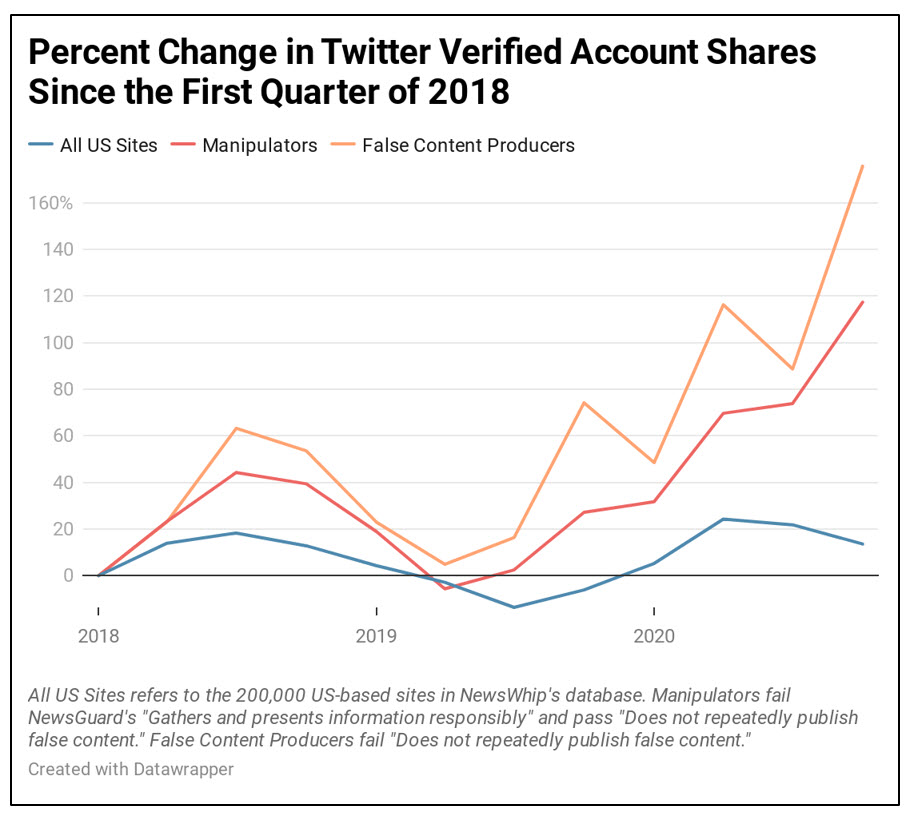
Deceptive sites have increased their reach at a faster rate than other web content. Since the first quarter of 2018,[1] False Content Producers have nearly tripled their verified account shares, while Manipulators have doubled theirs. Meanwhile, all U.S. sites have grown their verified account shares just 14 percent.
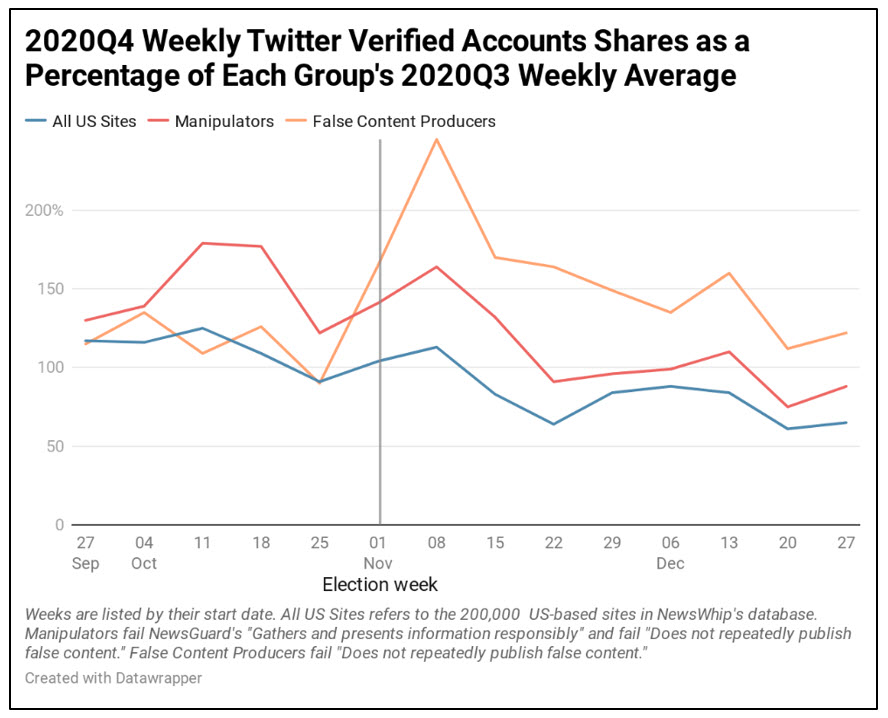
Most of the increase in False Content Producer verified account shares occurred after the election. False Content Producers slightly outpaced their third quarter average in the run-up to the election, but their verified account shares skyrocketed in the weeks after. Manipulators also outperformed their third quarter weekly shares average in the weeks surrounding the election. Overall, U.S.-based sites received fewer shares in the fourth quarter than in the third, especially in the weeks after the election.
The top-performing articles from deceptive sites, which drove their fourth quarter growth, centered on politics and advanced falsehoods about the election. Sixty-two of the top 100 articles from deceptive sites included false claims of voter fraud. Fifteen articles were about Hunter Biden. For example, among the top articles on Twitter were:
-
“I Was In Philadelphia Watching Fraud Happen. Here’s How It Went Down,” The Federalist (False Content Producer).
-
“Exclusive — ‘This is China, Inc.’: Emails Reveal Hunter Biden’s Associates Helped Communist-Aligned Chinese Elites Secure White House Meetings,” Breitbart (Manipulator).
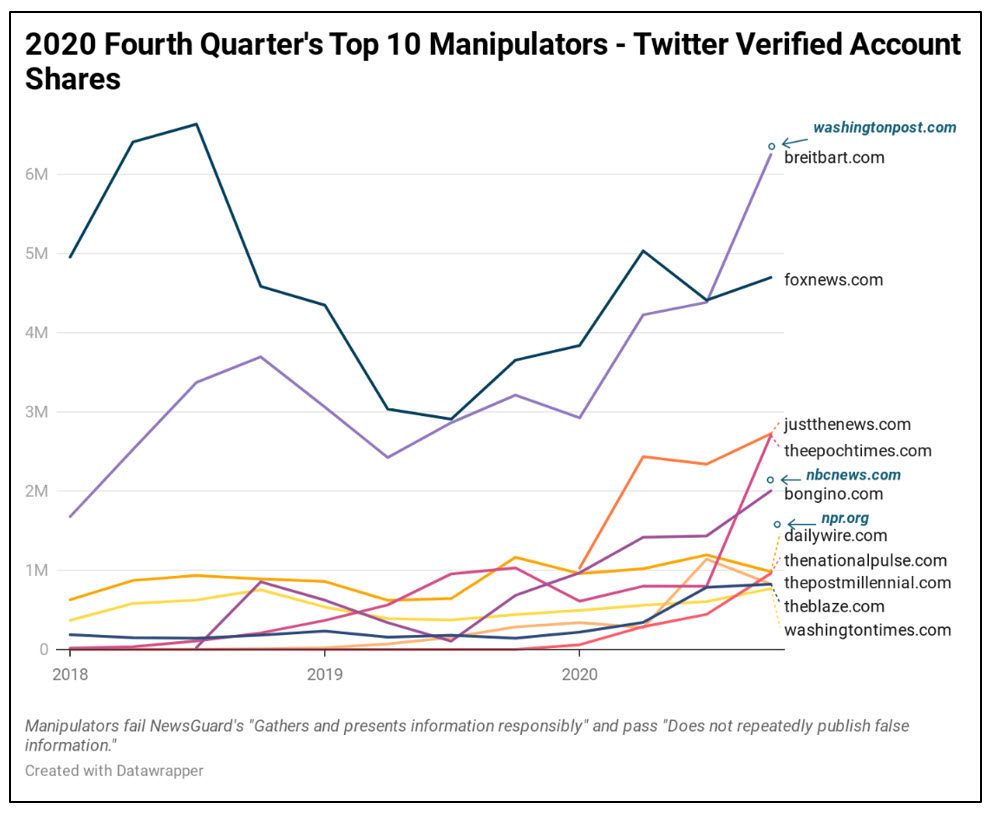
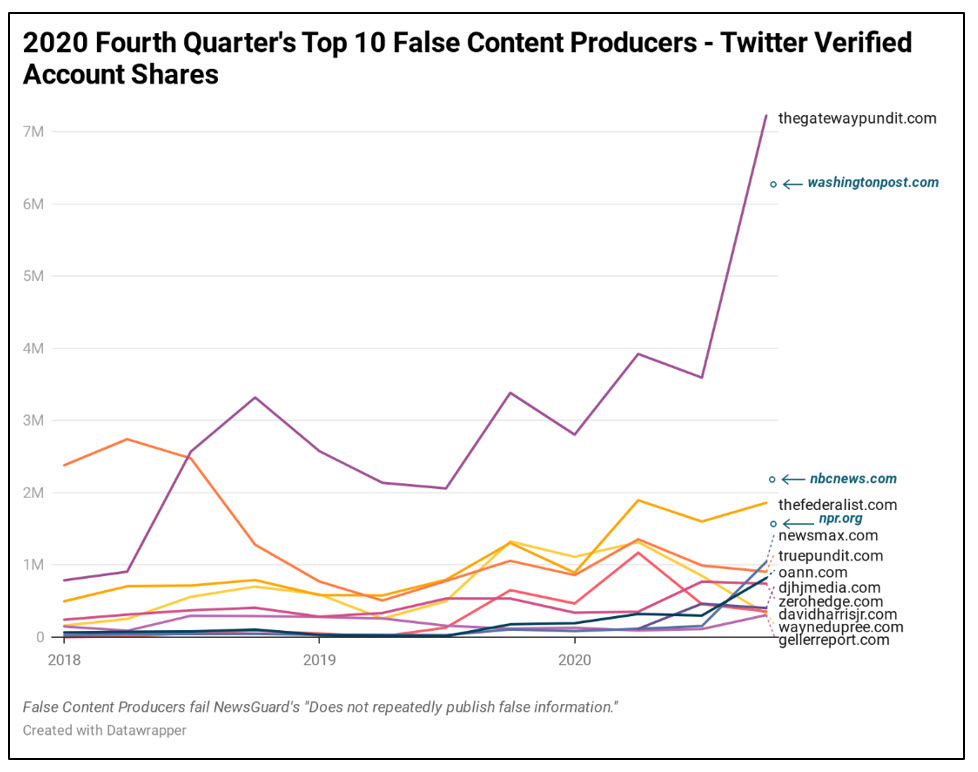
The top-performing deceptive sites tend to get similar numbers of verified account shares as the leading reputable outlets (sites with a perfect NewsGuard rating). The Gateway Pundit and Breitbart garnered 7.2 million and 6.2 million verified account shares, respectively, while The Washington Post received 6.3 million verified account shares, NBC News received 2.2 million, and NPR received 1.6 million. Newsmax’s verified account shares skyrocketed: during the fourth quarter of 2020, Newsmax had over 1 million verified account shares on Twitter. Its previous high, in the third quarter, was 153,000 shares.
There is some question as to whether the increase in verified account shares of articles from deceptive sites may be driven by an increase in the number of deceptive sites or an increase in the volume of content produced by such sites. While some of the sites in our data set did not exist in the first quarter of 2018, most of the top-producing sites did. And, while the overall volume of deceptive content has increased, our research revealed an uptick in the number of verified account shares per article.
Detailed Findings: Facebook
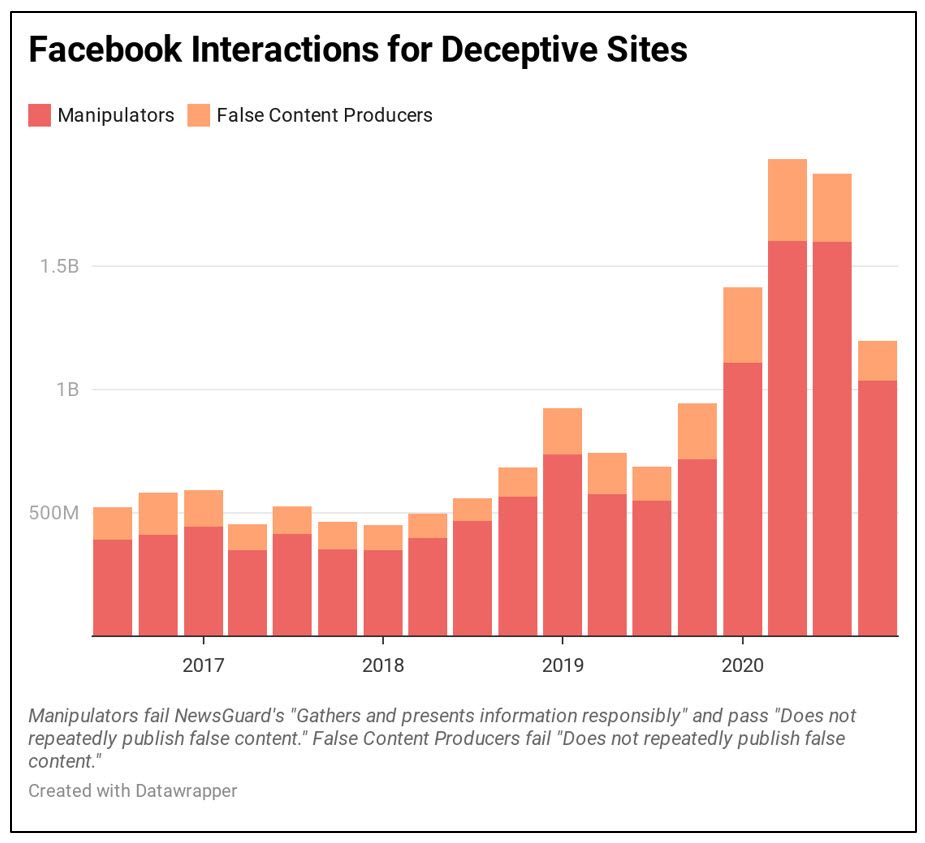
Interactions with deceptive sites on Facebook remained more than twice as high as in the run-up to the 2016 election. Most of those interactions—87 percent—were with Manipulators. And while the fourth quarter of 2020 saw a decline in Facebook interactions with all types of U.S.-based websites, the growth rate of Manipulators since the third quarter of 2016 remained higher than that of U.S. sites in general.
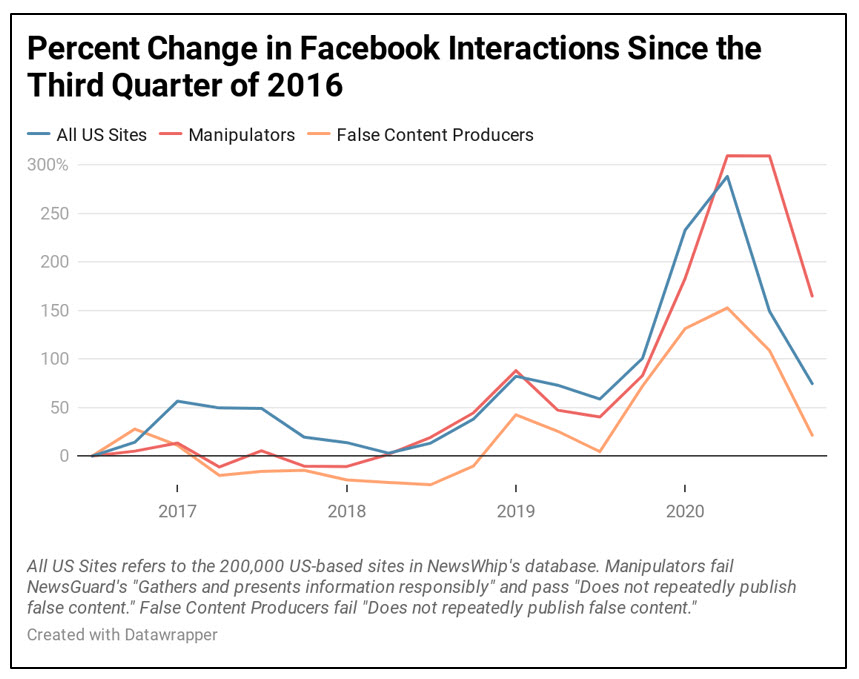
Manipulators have grown their interactions 165 percent since the third quarter of 2016, while all U.S.-based websites have grown theirs by 75 percent. False Content Producers have increased their interactions more slowly—by 21 percent since 2016. Combined, deceptive sites received 6.4 billion interactions in 2020—double that of any previous year. Although we cannot make direct qualitative comparisons between Facebook and Twitter because differences in the APIs prevent apples-to-apples comparison, 2020 was a record-setting year on both platforms.
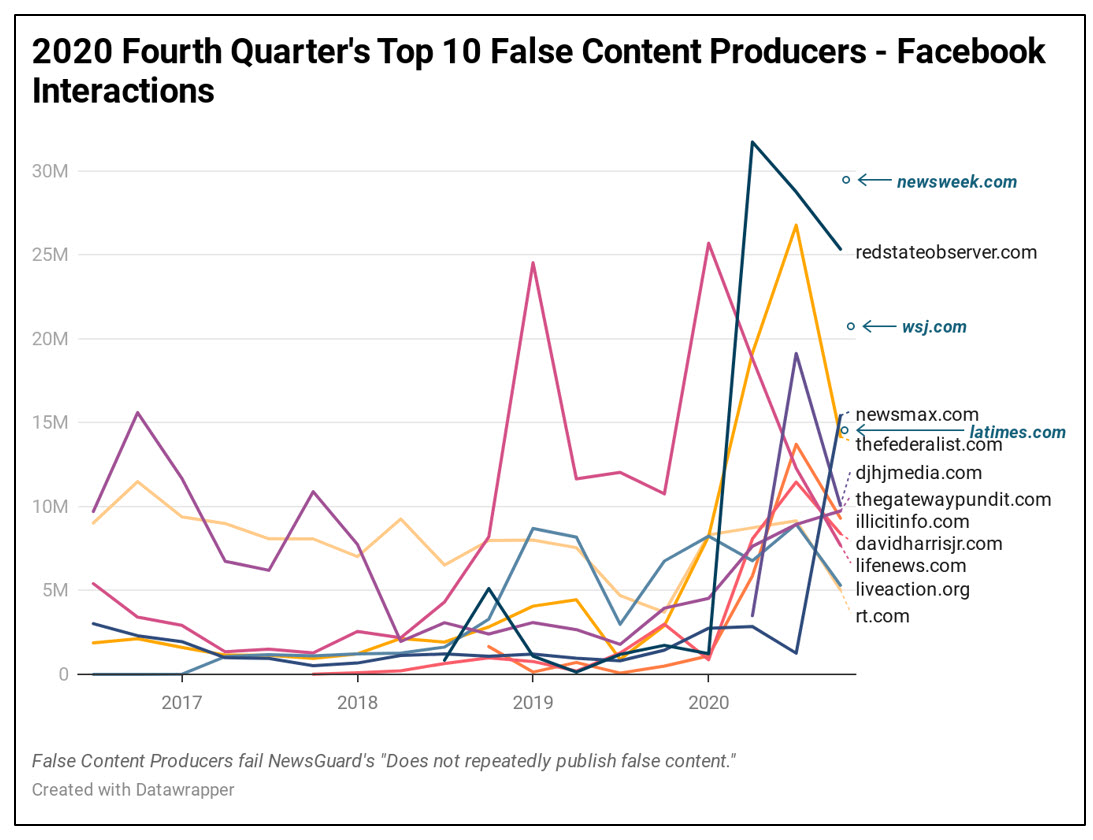
Despite the decline in interactions between the third quarter and fourth quarters of 2020, some False Content Producers increased their engagement on Facebook. Newsmax saw a significant rise in engagement and The Gateway Pundit had a small increase. The top False Content Producers have fewer interactions than the top reputable outlets—NBC News had 125 million interactions and The New York Times had 116 million—but similar numbers as Newsweek (29 million), The Wall Street Journal (21 million), and The Los Angeles Times (15 million). Many of the top-performing deceptive outlets are right-leaning, but there are left-leaning and apolitical sites within both categories.
The top-performing articles from deceptive outlets on Facebook were varied in their focus. Twenty-one of the top 100 articles were about the presidential campaign, while seventeen focused on claims of voter fraud after the election. Fifteen articles discussed the coronavirus, mostly in relation to Donald Trump’s diagnosis. For example, among the top articles on Facebook were:
-
“Schumer Urges FBI Director Not To Investigate Biden Scandal Before Election,” Western Journal (Manipulator).
-
“Second Georgia County Finds Thousands More Votes, Majority Are For Trump,” The Daily Wire (Manipulator).
-
“Forcing The Sick And Elderly To Die Alone Is Crueler Than COVID-19,” The Federalist (False Content Producer).
[1] Our Twitter data starts in the first quarter of 2018 because NewsWhip changed how it collects Twitter data in November 2017.
